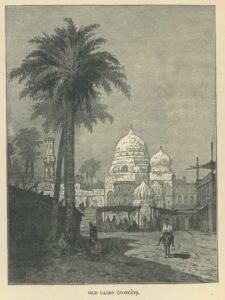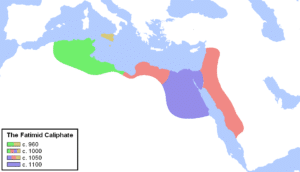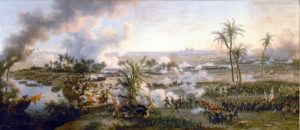The Arabs founded the capital of Egypt called Fustat, which was later burned down during the Crusades. Cairo was later built in the year 986 to grow to become the largest and richest city in the Arab Empire, and one of the biggest and richest in the world.

Abbasid Period:
The Abbasid period was marked by new taxation, and the Copts revolted again in the fourth year of Abbasid rule. At the beginning of the 9th century the practice of ruling Egypt through a governor was resumed under Abdallah ibn Tahir, who decided to reside at Baghdad, sending a deputy to Egypt to govern for him. In 828 another Egyptian revolt broke out, and in 831 the Copts joined with native Muslims against the government. Eventually the power loss of the Abbasids in Baghdad has led for general upon general to take over rule of Egypt, yet being under Abbasid allegiance, the Ikhshids and the Tulunids dynasties were among the most successful to defy the Abbasid Caliph.
The Fatimid Caliphate and the Mamluks:
Muslim rulers nominated by the Caliphate remained in control of Egypt for the next six centuries, with Cairo as the seat of the Fatimid Caliphate.

With the end of the Kurdish Ayyubid dynasty, the Mamluks, a Turco–Circassian military caste, took control about 1250. By the late 13th century, Egypt linked the Red Sea, India, Malaya, and East Indies. The mid-14th-century Black Death killed about 40% of the country’s population.
Ottoman Egypt (1517–1867):
Egypt was conquered by the Ottoman Turks in 1517, after which it became a province of the Ottoman Empire. The defensive militarization damaged its civil society and economic institutions. The weakening of the economic system combined with the effects of plague left Egypt vulnerable to foreign invasion. Portuguese traders took over their trade.Between 1687 and 1731, Egypt experienced six famines. The 1784 famine cost it roughly one-sixth of its population.
Egypt was always a difficult province for the Ottoman Sultans to control, due in part to the continuing power and influence of the Mamluks, the Egyptian military caste who had ruled the country for centuries.

Egypt remained semi-autonomous under the Mamluks until it was invaded by the French forces of Napoleon Bonaparte in 1798. After the French were defeated by the British, a power vacuum was created in Egypt, and a three-way power struggle ensued between the Ottoman Turks, Egyptian Mamluks who had ruled Egypt for centuries, and Albanian mercenaries in the service of the Ottomans.
The Muhammad Ali Dynasty:
After the French were expelled, power was seized in 1805 by Muhammad Ali Pasha, an Albanian military commander of the Ottoman army in Egypt. While he carried the title of viceroy of Egypt, his subordination to the Ottoman porte was merely nominal. Muhammad Ali massacred the Mamluks and established a dynasty that was to rule Egypt until the revolution of 1952.
